 Bedding out annual plants was a seasonal planting practice very popular from the late 1860’s until the turn of the century. Victorian gardeners, particularly of an English persuasion, reveled in planting seasonal and tropical plants in intricate patterns in ground resembling rugs. Or clocks. Or other objects and events. Or giant shapes all of one color and cultivar of plant. It seems so difficult to understand this concept of annual in ground gardening now, as modern gardeners are used to having thousands of cultivars of annual plants available to buy or grow from seed. What probably drove the fad as much as anything was the recent availability of tropical and annual plants that would bloom all summer long. The Victorian gardens took their plant choice liberation seriously. They planted everything they could find.
Bedding out annual plants was a seasonal planting practice very popular from the late 1860’s until the turn of the century. Victorian gardeners, particularly of an English persuasion, reveled in planting seasonal and tropical plants in intricate patterns in ground resembling rugs. Or clocks. Or other objects and events. Or giant shapes all of one color and cultivar of plant. It seems so difficult to understand this concept of annual in ground gardening now, as modern gardeners are used to having thousands of cultivars of annual plants available to buy or grow from seed. What probably drove the fad as much as anything was the recent availability of tropical and annual plants that would bloom all summer long. The Victorian gardens took their plant choice liberation seriously. They planted everything they could find.
 The Victorians-they embellished everything they had a mind to. Architecture, fashion-and gardening. I will confess to have bedded out many thousands of annual plants over a period of 10 years during my tenure as the garden designer for the Grand Hotel on Mackinac Island. Of course a resort hotel dating back to the Victorian era would ask for gardens reminiscent of the same period. One season I designed and Rob drew a scale plan for a for a long curving bed with the Stars and Stripes. Every bedding out garden I designed for them included decorative dirt. Those dirt spaces enabled discreet maintenance paths, but they also enabled a clear and crisp definition of the pattern.
The Victorians-they embellished everything they had a mind to. Architecture, fashion-and gardening. I will confess to have bedded out many thousands of annual plants over a period of 10 years during my tenure as the garden designer for the Grand Hotel on Mackinac Island. Of course a resort hotel dating back to the Victorian era would ask for gardens reminiscent of the same period. One season I designed and Rob drew a scale plan for a for a long curving bed with the Stars and Stripes. Every bedding out garden I designed for them included decorative dirt. Those dirt spaces enabled discreet maintenance paths, but they also enabled a clear and crisp definition of the pattern.
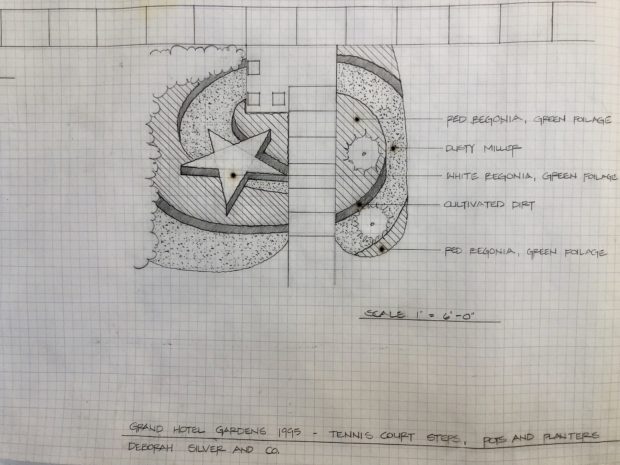 Even the simplest pattern relied on planting a large area for the pattern to read properly. Bedding out large areas took lots of plants. Annual plants are a fairly inexpensive source of gardening pleasure, but planting lots of them is expensive.
Even the simplest pattern relied on planting a large area for the pattern to read properly. Bedding out large areas took lots of plants. Annual plants are a fairly inexpensive source of gardening pleasure, but planting lots of them is expensive.
 Although few residential gardeners plant annuals in ground on this scale, some commercial properties still do a big job of bedding out annuals. The expansive shapes and bright colors are cheery and inviting. Detroit Garden Works does have a moderately sized annual garden out front, which is planted in a different way every year. It is part of what makes a visit to the shop enjoyable and interesting. We plant tulips in the spring, and hope the summer annuals persist until late fall. Though the Victorians embellished everything they touched, more modern gardeners are looking for a more simple splash of color. I do not bed out in the classical definition of the term any more. But I do plant seasonal plants in the ground. Any request for annual plantings in ground that come to me suggest a mix of plants.
Although few residential gardeners plant annuals in ground on this scale, some commercial properties still do a big job of bedding out annuals. The expansive shapes and bright colors are cheery and inviting. Detroit Garden Works does have a moderately sized annual garden out front, which is planted in a different way every year. It is part of what makes a visit to the shop enjoyable and interesting. We plant tulips in the spring, and hope the summer annuals persist until late fall. Though the Victorians embellished everything they touched, more modern gardeners are looking for a more simple splash of color. I do not bed out in the classical definition of the term any more. But I do plant seasonal plants in the ground. Any request for annual plantings in ground that come to me suggest a mix of plants.
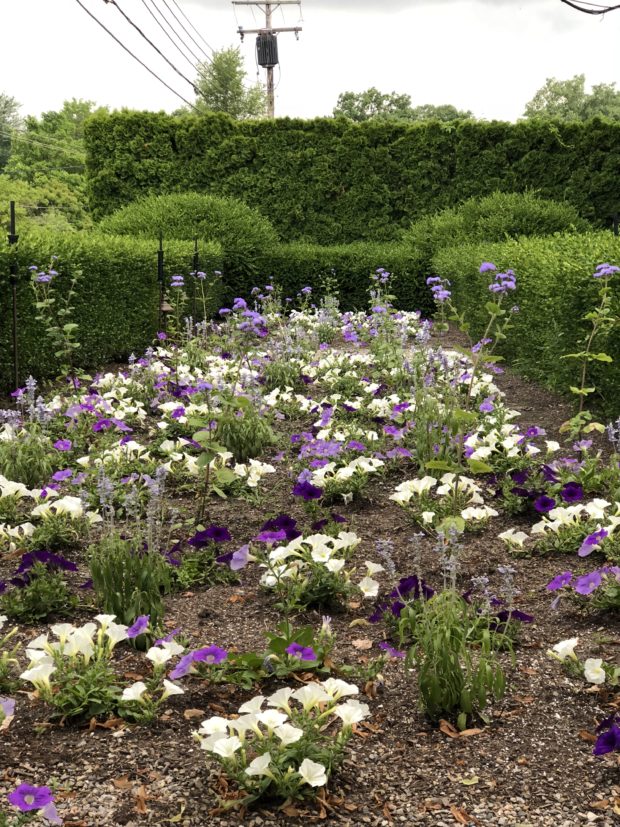 My primary attraction to a mix of plants has to do with spreading out the risk. If the salvia in this bed has a bad year, the petunias might be able to carry the day. It is just good planning to plant any large in ground area I need to plant with a collection of plants. I like to hedge my bets. The plant mix first and foremost asks for plants that like similar growing conditions.
My primary attraction to a mix of plants has to do with spreading out the risk. If the salvia in this bed has a bad year, the petunias might be able to carry the day. It is just good planning to plant any large in ground area I need to plant with a collection of plants. I like to hedge my bets. The plant mix first and foremost asks for plants that like similar growing conditions.
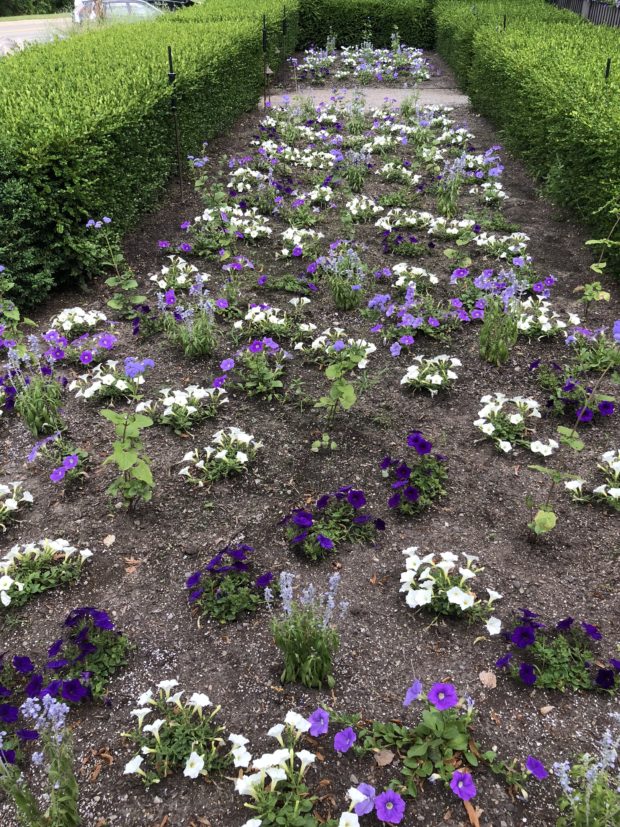 So I mix the plants before I mix the colors. Nature has a way of turning the tide when you least expect it, so I always design with the possibility of trouble in mind. Designing a mix is easy. You need three colors for a mix to be even. In this bed, I planted white petunias between each of the other colors. White lightens and brightens the overall scheme. White provides a very strong contract to every other color nearby – even pastel colors. Adding a 4th and 5th plant to a planting scheme can be very busy. Noisy, even. This bed with 3 types of plants- tall florist’s ageratum, petunias, and sky blue Cathedral salvia – and 5 colors will be visually fairly quiet, as all of the colors are closely related.
So I mix the plants before I mix the colors. Nature has a way of turning the tide when you least expect it, so I always design with the possibility of trouble in mind. Designing a mix is easy. You need three colors for a mix to be even. In this bed, I planted white petunias between each of the other colors. White lightens and brightens the overall scheme. White provides a very strong contract to every other color nearby – even pastel colors. Adding a 4th and 5th plant to a planting scheme can be very busy. Noisy, even. This bed with 3 types of plants- tall florist’s ageratum, petunias, and sky blue Cathedral salvia – and 5 colors will be visually fairly quiet, as all of the colors are closely related.
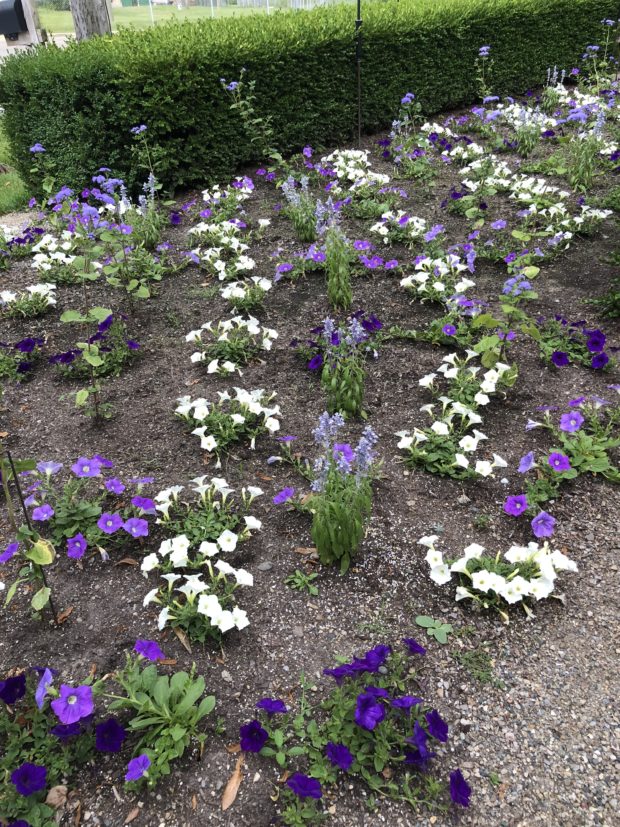 Viewed on the diagonal, this bed will have distinct stripes, given the placement of the white petunias between each of the other two petunia colors. I will be interested to see how the look shifts from different points of view once this bed has grown in. I rarely plant at the shop until all of my clients have their flowers, so this was planted but 2 weeks ago. Given that the soil is warm, they will grow fast. To follow are pictures of a few of the in ground plantings we did this year.
Viewed on the diagonal, this bed will have distinct stripes, given the placement of the white petunias between each of the other two petunia colors. I will be interested to see how the look shifts from different points of view once this bed has grown in. I rarely plant at the shop until all of my clients have their flowers, so this was planted but 2 weeks ago. Given that the soil is warm, they will grow fast. To follow are pictures of a few of the in ground plantings we did this year.
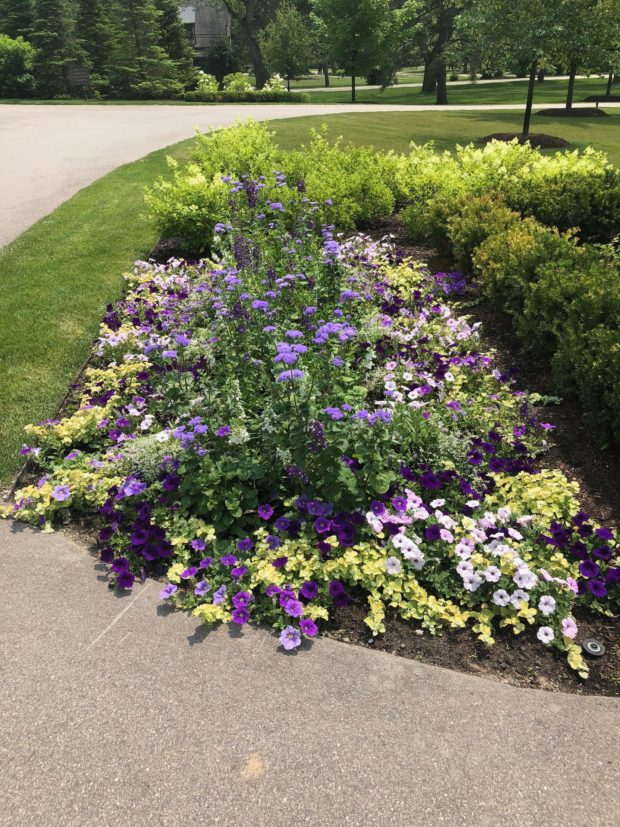 This is a relatively small planting area, but a small planting area does not have to be uninteresting. The biggest challenge will be keeping water intended for the lawn out of this area. All of these plants thrive in fairly dry conditions once they are established.
This is a relatively small planting area, but a small planting area does not have to be uninteresting. The biggest challenge will be keeping water intended for the lawn out of this area. All of these plants thrive in fairly dry conditions once they are established.
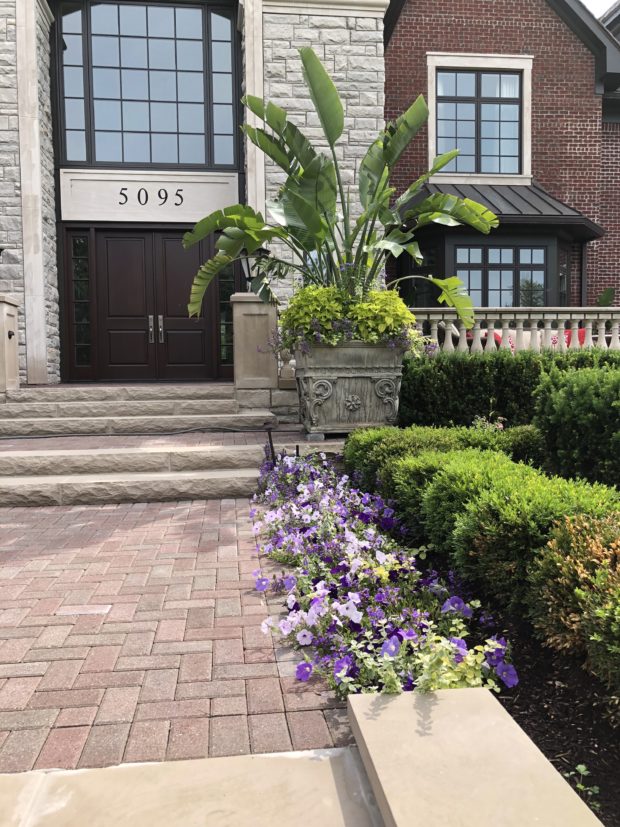 The other small planting areas on either side of the walk feature a purple mix of petunias and scaevola, punctuated with a dash of lime licorice.
The other small planting areas on either side of the walk feature a purple mix of petunias and scaevola, punctuated with a dash of lime licorice.
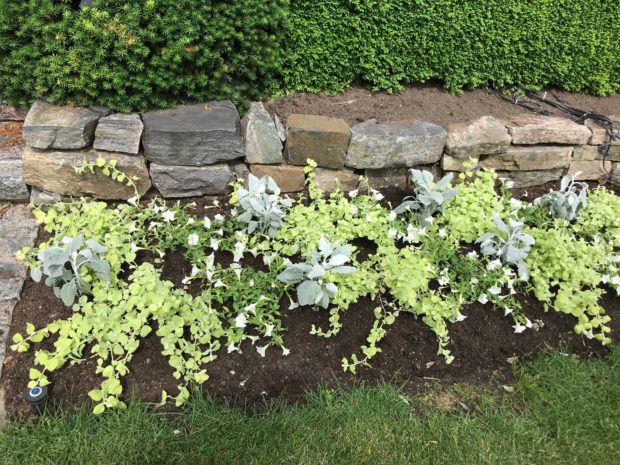 White petunias, cirrus dusty miller, and lime licorice make for an unusual color scheme, which is exactly what my clients like.
White petunias, cirrus dusty miller, and lime licorice make for an unusual color scheme, which is exactly what my clients like.
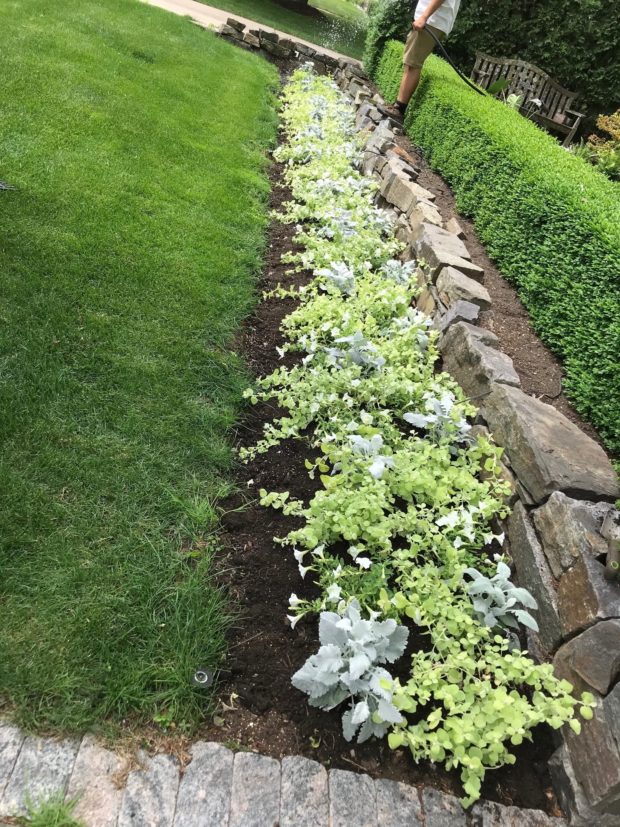 The cirrus dusty miller will provide a little height, and the licorice and petunias will weave in and out of one another.
The cirrus dusty miller will provide a little height, and the licorice and petunias will weave in and out of one another.
 The mix in the pots is pink, red and red violet, leavened with variegated licorice.
The mix in the pots is pink, red and red violet, leavened with variegated licorice.
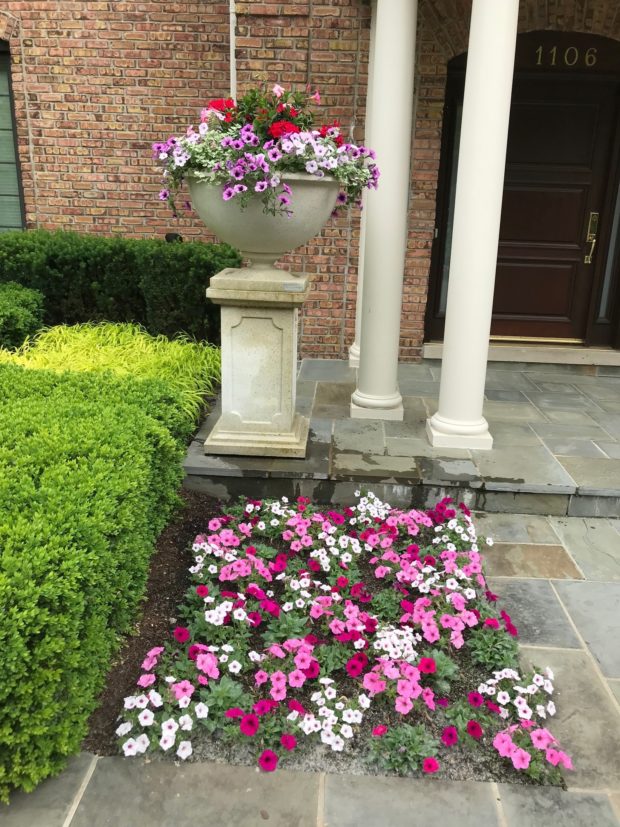 in ground, a mix of 3 colors of petunias.
in ground, a mix of 3 colors of petunias.
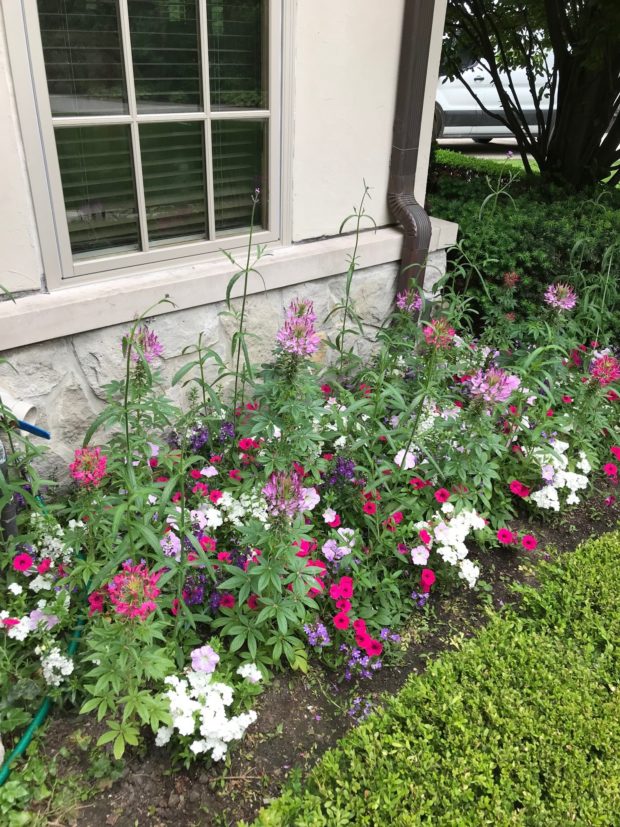 This small garden area features 2 colors of dwarf cleome, verbena bonariensis, petunias in several colors, white angelonia and white phlox.
This small garden area features 2 colors of dwarf cleome, verbena bonariensis, petunias in several colors, white angelonia and white phlox.
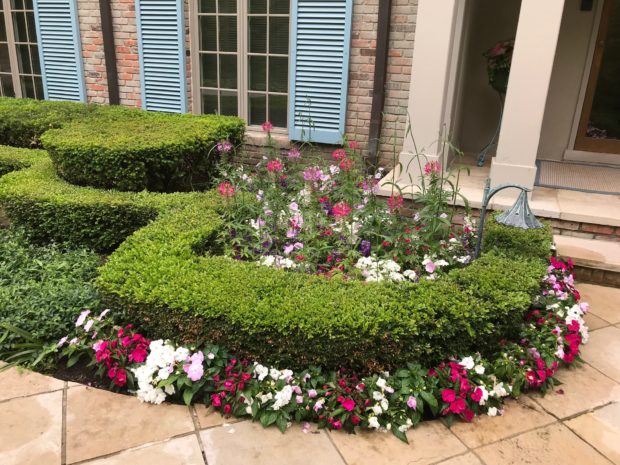 A little 4th of July style visual fireworks will energize this small space at the side door all summer long.
A little 4th of July style visual fireworks will energize this small space at the side door all summer long.